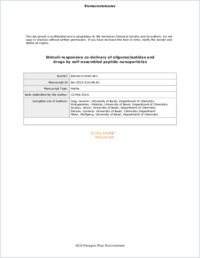Stimuli-Responsive Codelivery of Oligonucleotides and Drugs by Self-Assembled Peptide Nanoparticles.
- Sigg SJ Department of Chemistry, University of Basel , Klingelbergstrasse 80, CH-4056 Basel, Switzerland.
- Postupalenko V Department of Chemistry, University of Basel , Klingelbergstrasse 80, CH-4056 Basel, Switzerland.
- Duskey JT Department of Chemistry, University of Basel , Klingelbergstrasse 80, CH-4056 Basel, Switzerland.
- Palivan CG Department of Chemistry, University of Basel , Klingelbergstrasse 80, CH-4056 Basel, Switzerland.
- Meier W Department of Chemistry, University of Basel , Klingelbergstrasse 80, CH-4056 Basel, Switzerland.
- 2016-02-13
Published in:
- Biomacromolecules. - 2016
Boron Compounds
Dipeptides
Drug Carriers
Gramicidin
HeLa Cells
Humans
Hydrophobic and Hydrophilic Interactions
Nanoparticles
Oligonucleotides, Antisense
Static Electricity
English
Ever more emerging combined treatments exploiting synergistic effects of drug combinations demand smart, responsive codelivery carriers to reveal their full potential. In this study, a multifunctional stimuli-responsive amphiphilic peptide was designed and synthesized to self-assemble into nanoparticles capable of co-bearing and -releasing hydrophobic drugs and antisense oligonucleotides for combined therapies. The rational design was based on a hydrophobic l-tryptophan-d-leucine repeating unit derived from a truncated sequence of gramicidin A (gT), to entrap hydrophobic cargo, which is combined with a hydrophilic moiety of histidines to provide electrostatic affinity to nucleotides. Stimuli-responsiveness was implemented by linking the hydrophobic and hydrophilic sequence through an artificial amino acid bearing a disulfide functional group (H3SSgT). Stimuli-responsive peptides self-assembled in spherical nanoparticles in sizes (100-200 nm) generally considered as preferable for drug delivery applications. Responsive peptide nanoparticles revealed notable nucleotide condensing abilities while maintaining the ability to load hydrophobic cargo. The disulfide cleavage site introduced in the peptide sequence induced responsiveness to physiological concentrations of reducing agent, serving to release the incorporated molecules. Furthermore, the peptide nanoparticles, singly loaded or coloaded with boron-dipyrromethene (BODIPY) and/or antisense oligonucleotides, were efficiently taken up by cells. Such amphiphilic peptides that led to noncytotoxic, reduction-responsive nanoparticles capable of codelivering hydrophobic and nucleic acid payloads simultaneously provide potential toward combined treatment strategies to exploit synergistic effects.
- Language
-
- English
- Open access status
- green
- Identifiers
-
- DOI 10.1021/acs.biomac.5b01614
- PMID 26871486
- Persistent URL
- https://sonar.ch/global/documents/247481
Statistics
Document views: 11
File downloads:
- fulltext.pdf: 0
